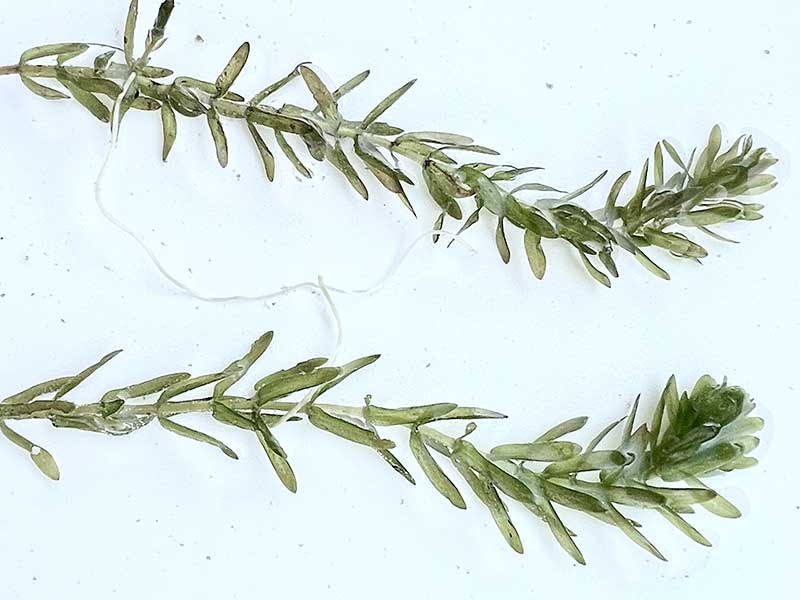Elodea canadensis / Elodea
- submerged with a stem and whorls of small, oblong leaves
- usually has 3 leaves per node
- leaf whorls denser near the growing tips
- stems may be quite long or floating as fragmented bits
Also known as: American/Canadian waterweed, water thyme, ditch moss, broad waterweed
Synonyms: Anacharis canadensis
Elodea is a perennial, submerged aquatic monocot, often found in hard water near stream inlets. It is not particularly common anywhere that I know in the Teton River, and the photos in the gallery show plant fragments that were floating near shore at the Big Eddy. Otherwise, it is most likely found tangled up with sago pondweed, especially where small streams join the river.
If you pull a handful of green stuff out of the river, or snag it with a paddle or fishing lure, Elodea is the one with bright green, translucent leaves. They are this way because the leaf has only two layers of cells (top to bottom) and they are filled with huge (relatively speaking) chloroplasts. The leaves are oblong, ranging up to ¾ inches long and perhaps ⅛ inches across. Their tips are more rounded than pointy (a distinguishing feature). They are attached to the stem, without petioles, usually in whorls of three, but rarely in groups of two or four. As would be expected from a plant elongating from an apical meristem, the leaf clusters are more dense near the tip. Overall, single stems of Elodea can be up to 10 feet long.
Although Elodea lives entirely underwater, it makes an exception for its flowers. These are extremely teeny, white to pale purple, and float on the surface. The long, delicate stalk connecting the flowers with the rest of the plant is actually fused petals, making these incredibly long tubular flowers. Your chances of finding these is really small, however. Elodia is dioecious and the pollen has to float until it finds a female flower. Since populations are not half-and-half, the end result is that seed production happens rarely.
The more common mode of Elodea propagation is by fragmentation. The stems are brittle and easily break off and float away. Although young plants (from seed) are rooted in the river bottom substrate, the floating plants produce adventitious roots for nutrient uptake and may root if they hit the bottom. Particularly in such cases, the population can be rather densely bushy.
Certainly in dense colonies, Elodea is not ideal fish habitat, but they are pretty good cover for crustaceans, insect larvae and snails.
An upshot of the ability to grow in dense colonies is that any web search for Elodea is guaranteed to bring up many pages related to its control as a weed. It reaches this “problem” status especially in high nutrient, stagnant waters. Fortunately, most western rivers, inducing the Teton, do not have that problem.
But regardless of propagation methods or ability to grow quickly, perennial plants still need to make it through the winter. Like several other aquatics on this site, Elodea produces hard buds (turions) which sink to the bottom in fall, and produce new plants in spring.
Interesting bits – Because the leaves are so thin, the oxygen released by photosynthesis can easily diffuse out through cell membranes and walls. For that reason, Elodea is known for its capacity to oxygenate water. In addition, by rapidly absorbing nutrients, it helps control algae and keep waters clear. However, it also accumulates heavy metals from the water. The good side of this is that Elodea is useful for phytoremediation. The flip side is that it makes the plant more toxic to grazers such as moose. (This is one reason that moose don’t eat entirely in the water).
Finally, because the leaves are so thin and the chloroplasts so relatively large, Elodea is a great plant to demonstrate cytoplasmic streaming. Since I do not currently have a microscope to show this, I’m including a YouTube video that shows how cool it is. Note: if you look at other videos of this phenomenon, the chloroplasts are all moving much more slowly. This (in my experience) is because the detached leaves were photographed too soon after cutting. With additional time, the process recovers.
| Blossom size | |
|---|---|
| Color | |
| Family | |
| Inflorescence size | |
| Inflorescence type | |
| When? | |
| Where? |


